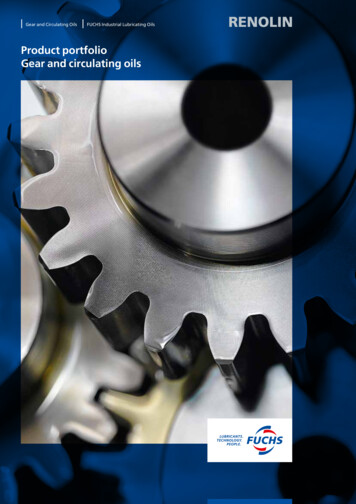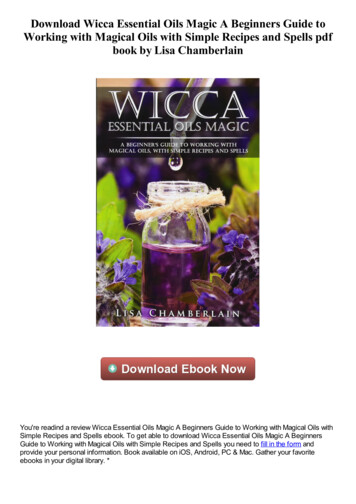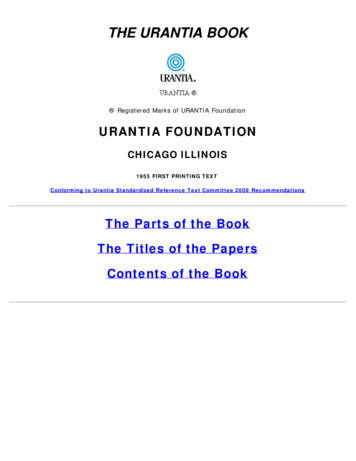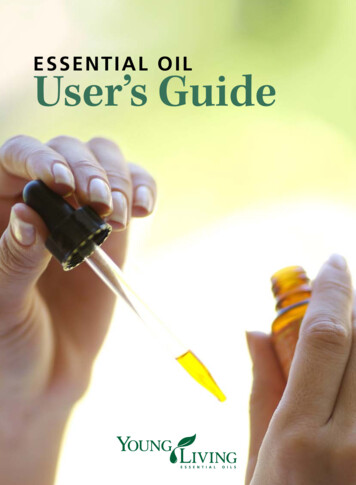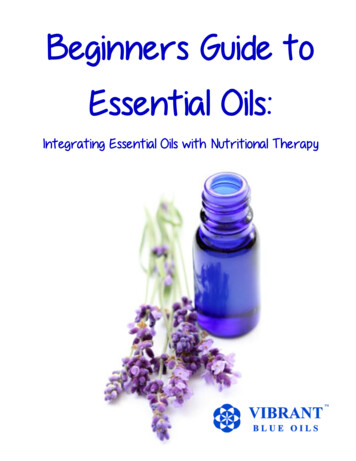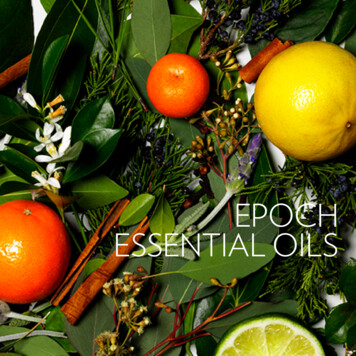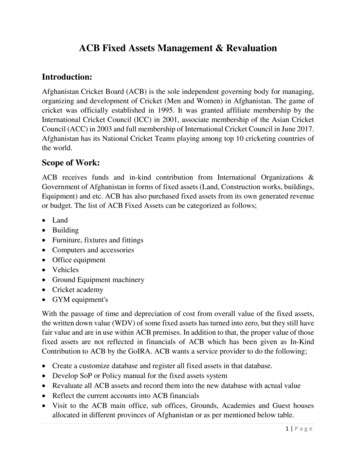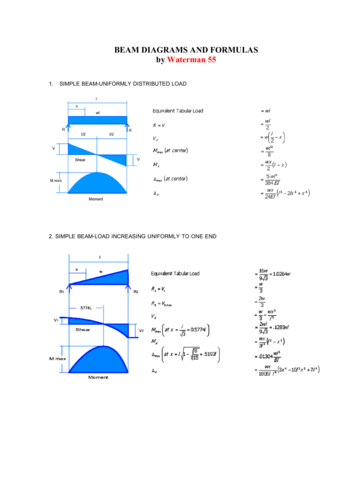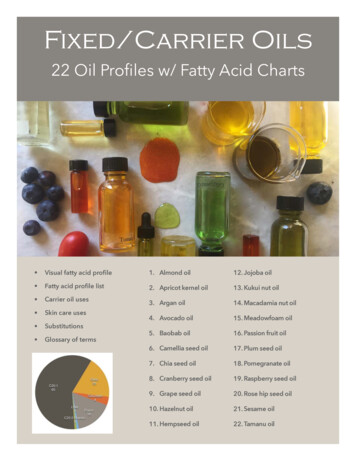
Transcription
Fixed/Carrier Oils22 Oil Profiles w/ Fatty Acid Charts Visual fatty acid profile1. Almond oil12. Jojoba oil Fatty acid profile list2. Apricot kernel oil13. Kukui nut oil Carrier oil uses3. Argan oil14. Macadamia nut oil Skin care uses4. Avocado oil15. Meadowfoam oil Substitutions Glossary of terms5. Baobab oil16. Passion fruit oil6. Camellia seed oil17. Plum seed oil7. Chia seed oil18. Pomegranate oil8. Cranberry seed oil19. Raspberry seed oil9. Grape seed oil20. Rose hip seed oil10. Hazelnut oil21. Sesame oil11. Hempseed oil22. Tamanu oil
Fixed/Carrier Oils22 Oil Profiles w/ Fatty Acid Charts22 fixed carrier oilsA quick guide to 22 fixed/carrier oils for essentialoils, making salves and balms and use in skincare.This e-book gives you the properties, fatty acidprofiles, use and substitutions for 22 carrier oils.Each oil has its own pie chart of the fatty acidmake up in pictorial form and a traditional chartby percentages plus a photograph of the oil. Oilsperform on the skin differently depending on theirfatty acid make up whether it be a highly saturatedbutter, monounsaturated almond oil or highlyunsaturated chia seed oil. Having a glancingfamiliarity with these properties will help youchoose the best fixed carrier for your blendedproducts.All fixed oils have color, aroma and nourishingproperties that can improve your blend.A tip when purchasing fixed oils is to sample asmall amount before stocking up. Sometimesscent or color or texture may not work for you.Oils vary by source, supplier and level ofrefinement. Some fixed oil scents can be overcome by creative blending with the essential oilswhile others pose more of a challenge.These are just a few of the many fixed oils usedas carriers and base oils. This is a reference, andan introduction to an amazing adventure intothe other oils.Each listing includes:‣‣‣‣Pie chart and fatty acid profilePhoto of the oil and seed source if available.Benefits of the oilNotes on scent, suitability, and other usefulmaterial.
Almond OilAmygdalus communisblends, aromatherapy essential oil blends,balms, facial serums and skin conditioning.Almond oilAlmond oil’s stability, mild odor and lightcolor make it an excellent general purposecarrier oil. It is high in monounsaturated oleicacid and rich in vitamin E and minerals. Thehigh vitamin E content keeps almond oil fromoxidizing rapidly, extending the shelf life.Naturally occurring plant sterols help calmredness and support collagen productionand skin tissues The relatively generouslinoleic acid percentage allows it to absorbsinto the skin fairly rapidly.Almond oil is commonly used in babyproducts because it is mild and nourishing.An excellent all round oil good for massageSubstitutions: apricot kernel oil, plum kerneloil, peach kernel oil‣‣‣‣‣‣High in vitamin EContains squalene, an important skin lipidContains anti inflammatory plant sterolsglycosidesVery emollient and sustainingMember of the rose Rosaceae familyOleic acidLinoleic acidPalmitic acidStearic acidAlpha-linolenicUnsaponifiablesSusan M Parker 201770%25%6%2%0.4%1%.
Apricot kernel oilPrunus armeniacaApricot kernel oilApricot kernel oil is a mild oil especially goodfor sensitive skin. It is even typically welltolerated by people with nut allergies. It helpsmaintain moisture in the skin keeping it softand healthy. Apricot oil is very similar toalmond oil. Apricot kernel oil is excellent formature skin due to its small percentage ofomega 7 palmitoleic acid, a fatty acid.Substitutions: almond oil, peach kernel oil,plum kernel oilThe oil has the mild bitter almond scent ofmarzipan. The pleasant, but strong scent isn'talways desirable when creating essential oilblends.Oleic acidLinoleic acidPalmitic acidStearic acidPalmitoleic acid65%26%5%2%2%Alpha-linolenic1%Apricot kernel oil is excellent for massage,skin serums, infusing herbs and flowers, andfor sensitive skin conditions.‣‣‣‣‣‣High in vitamin EPossessing nitrillosides, another name for B17Anti inflammatory beta-sitosterolMild almond/marzipan scentEmollient, helps preserve moistureMember of Rosaceae botanical familyUnsaponifiablesSusan M Parker 20170.6%
Argan OilArgania spinosaArgan oilArgan oil has a beautiful balance ofmonounsaturated oleic acid andpolyunsaturated linoleic acid that gives itprotective qualities with fast absorption thatdoesn't leave the skin feeling oily. Argan treesare adapted to harsh dry conditions and the oilproduced from argan nuts brings theseadaptive qualities to skin care, making it a goodoil for very dry skin conditions. It is a nutritiousoil with generous antioxidant compoundsincluding vitamin E and the provitamin Acarotenes. Naturally occurring polyphenolscalm inflammation and redness. Argan oil isfrom Morocco. In the picture above, goatsclimb an argan tree to eat the nutritious nuts.Argan oil has a strong odor unless deodorized.Substitutions: baobab oil, kukui oil, sesame oil‣‣‣‣‣‣High in vitamin EGenerous antioxidants, carotenesContains nourishing polyphenolsSqualene contentCan have a strong odor if not deodorizedReferred to as Liquid Gold by Moroccan’sOleic acidLinoleic acidPalmitic acidStearic acidAlpha-linolenicEicosenoic acidUnsaponifiablesSusan M Parker 201746%3612%5%0.5 %0.5%1%
Avocado OilPersea gratissimaAvocado oilPressed from the fruit of the avocado, the oil isrich in vitamins, minerals, amino acids as wellas cell strengthening phospholipids. This richoil is perfect for mature skin. It is high inomega 7, palmitoleic acid. Our skin producesthis natural fatty acid when young but as weage, oils like avocado help replenish thisimportant skin lipid.Pro vitamin A carotenoids are powerfulantioxidants that help to protect the skin fromenvironmental damage, while plant sterolssupport the structure of the skin and collagento maintain skin tone. Excellent for matureskin, exceptionally dry or depleted skin, andfor massage.Illustration above shows two levels of refined oil,the darker one retaining more of the natural plantcompounds of the oil.Substitutions: macadamia nut oil, gevuina orChilean hazelnut oil.‣‣‣‣‣High in vitamins B and EContains cell supporting phospholipidsPro vitamin A carotenoidsHigh in omega 7 Palmitoleic acidPhyto sterols support collagen healthOleic acidPalmitic acidLinoleic acidPalmitoleic acidAlpha-linolenicStearic acidSusan M Parker 201770%16%12%10%4%2%
Baobab OilAdansonia digitataand neutral, ideal as a carrier oil, or as the baseand foundation in a formula.Baobab oilBaobab, called the upside down tree, can livefor thousands of years, a quality that brings asimilar vitality to the oil produced from the nuts.It is a beautifully balanced oil dominated byoleic and linoleic acids which nourishes skintissues while the saturated palmitic acid protectsagainst weather and environmental damage.Vitamins, minerals and other botanicalcompounds found in the oil make baobabparticularly good for cellular regeneration andrepair. Plant compounds help support thecollagen and skin tissue elasticity, crucial formaintaining a vibrant skin tone. The scent is mildSubstitutions: argan oil, brazil nut oil‣‣‣‣‣‣‣Provitamin A, carotenesVitamin E, tocopherolOxidative stabilityReparative skin damage and UV exposureHas its own botanical family BombacaceaeCalled the upside down treeAbsorbs quickly and deeplyOleic acidLinoleic acidPalmitic acidStearic acidAlpha-linolenicSusan M Parker 201735%28%24%6%3%
Camellia OilCamellia seninsisCamellia seed oilSubstitutions: hazel nut oil, almond oilCamellia seed oil, pressed from the seeds of thetea plant is high in tannins, similar to the tanninsfound in a cup of tea. The naturally presenttannins in camellia seed oil tame the overproductive sebaceous glands that cause oilyskin. The astringent properties of camellia seedoil helps rebalance, protect and tone oily skin.‣‣‣‣‣‣‣‣It is a clear oil without odor and a dry feel on theskin. These combined properties make it idealas a carrier oil for essential oil blends. It is rich inpolyphenols, vitamins and minerals andsqualene, all good skin nourishing properties.Oleic acidLinoleic acidPalmitic acidStearic acidAlpha-linolenicArachidic acidAstringent, tanninsAntioxidants protect against damageOxidative stabilityVitamins A, B, E & squaleneTea, Theaceae, botanical familyAbsorbs with a dry feelA popular in its native JapanKnown as tsubaki oil in JapanSusan M Parker 201780%9%9%1%1%1%
Chia seed OilSalvia hispanicaChia seed oilChia seed oil is one of the few oils very high inthe omega 3, alpha-linolenic acid which is oneof the an essential fatty acids. It is a drying oilthat is moderately stable against oxidation. Itshigh polyunsaturated fatty acid content isnourishing to dry, depleted skin.The amounts of antioxidant compounds in chiaseed oil helps protect this highly unsaturated oilfrom oxidation. Anti-inflammatory compoundsin chia seed oil contribute healing actions. It isperfect for therapeutic massage oil formulawhen mixed with less saturated oils. Polyphenols and carotenoids support skin healthand help repair damage from all sources.Substitutions: kiwi seed oil, rose hip seed oil,‣‣‣‣‣‣‣Extremely high omega 3 alpha-linolenic acidGenerous antioxidants, carotenesRelative oxidative stability for its omega 3 contentReparative of skin damage, UV exposureLamiaceae, mint, botanical familyAbsorbs quickly and deeplyHigh in zinc and other mineralsAlpha-linolenic acid LNALinoleic acidOleic acidPalmitic acidStearic acidSusan M Parker 201760%21%9%7%2%
Cranberry OilVaccinium macrocarponCranberry seed oilSubstitutions: blueberry seed oil, rose hip seedoilCranberry seed oil has a beautiful complementof fatty acids and is one of the most balancedoils. The oil has generous amounts of theessential fatty acids, linoleic and alpha-linolenicacids that are deeply moisturizing to the skin.The oleic acid helps stabilize the oil and slowsoxidation. The oil is also packed withantioxidants and other plant compounds.‣‣‣‣‣‣‣Provitamin A, carotenes, polyphenols, anthocyanidins and a host of other antioxidantsprotect against free radical damage. Cranberryis considered one of the dry oils whose tanninshelp tone the skin and prevent over productionof natural oils, important for those with oily skin.Phospholipid contentGenerous antioxidants, carotenes, the cyanadinsOxidative stabilityReparative of skin damage and UV exposureBalanced fatty acid structureAbsorbs quickly and deeplySame botanical family Vacciinium as blueberryLinoleic acidAlpha-linolenicOleic acidPalmitic acidStearic acidPalmitoleic acidSusan M Parker 201740%28%24%5%1%0.5%
Grape seed OilVitis viniferaGrape seed oilGrapeseed oil is a light, fast absorbing oil highin linoleic acid. It is rich in vitamins andminerals that protect and nourish the skin.Grapeseed oil contains the flavonol proanthocyanidin which acts to helps strengthenand support collagen and elastin in theunderlying skin tissues. Grape seed oil is mildwith little to no scent however it comes in awide range of color from almost clear to deepgreen depending on the source of the grapeseeds used and the level of refinement.Astringent properties make this a dry oil,protective and penetrating without leaving anoily or greasy feel. It contains naturallyoccurring vitamin E which protectsagainst damage and helps repair and nourishthe tissues.Substitutions: safflower oil, passion fruit seed oil,cucumber seed oil.‣‣‣‣‣‣Tannins make it an astringent dry oilVitamin and mineralsProanthocyanidin are anti inflammatoryHigh in vitamin EAbsorbs quickly and deeplyMild for sensitive skinLinoleic acidOleic acidPalmitic acidStearic acidAlpha-linolenicPalmitoleic acidSusan M Parker 201775%20%8%5%2%0.6%
Hazelnut OilCorylus avelianaHazelnut oilOleic acid makes up 75% of hazel nut oil, that,combined with tannins naturally present in heoil make it slightly astringent. Hazel nut oil ismild with minimal odor, ideal as a neutral basefor essential oils. You can also use hazelnut oil incooking. The tannins benefit the the skinpromoting circulation while the generoussqualene content nourishes skin lipids.Hazelnut oil is especially good for oily skin withover active sebaceous glands. It helps to calmoil production and tighten the pores. It isconsidered a dry oil, penetrating withoutleaving an oily or greasy feel. High vitamin Econtent protects against oxidative damage andhelps repair and nourish the tissues.Substitutions: camellia oil, almond oil, marulaoil.‣‣‣‣‣‣‣Tannins make it an astringent dry oilVitamin and mineralsBeta sitosterol calms inflammationHigh in vitamin EAbsorbs quickly and deeplyMild for sensitive skinContains squaleneOleic acidLinoleic acidPalmitic acidStearic acid75%10%5%3%Unsaponifiables1.5%Susan M Parker 2017
Hemp seed OilCannabis indicaSubstitutions: blackberry seed oil, rose hip seedoilHemp seed oilHemp seed oil has an unusual range of fattyacids that make it highly nourishing and healing,including beneficial GLA and SDA.GLA is anti-inflammatory helping to reduceredness and support the skin’s innate immunesystem. While SDA’s highly unsaturatedstructure aids in treating skin blemishes andother inflammatory skin conditions. Stearidonicfatty acid has a highly unsaturated structure, thatcombined with linoleic and alpha-linolenic acidscreates an oil with powerful skin healingproperties.‣‣‣‣‣‣Absorbs wellGLA fatty acid for inflammationStearidonic acid anti inflammatory and bridge FAReparative of skin damageProtective of skinCalled “nature’s perfectly balanced oil”Linoleic acidAlpha-linolenicOleic acidPalmitic acidStearic acidGamma linoleic acid C18:3Arachidic acid C20:0Stearidonic acid C18:4Susan M Parker 201755%20%14%7%3%4%2%2%
Jojoba OilSimmondsia chinensisJojoba oilYes, it’s a wax and technically not an oil, but it isliquid at room temperatures and we use it in thesame manner as true oils. Jojoba’s very longchains of fatty acids are linked by ester bondsand not triglycerides. It has a similar fatty acidcomposition to meadowfoam seed oil (which isa true oil) making these two interchangeable informulas.Jojoba oil has a similar structure to the skin'snatural sebum. This makes it highly compatiblewith most skin types. Jojoba’s ability to absorbinto the top layers of skin is an added, ifunexpected bonus for this oil. High in vitamin E,jojoba supplies antioxidant protection againstenvironment and weather. It is a light colored oilwith no aroma. An all purpose oil for skin careand a carrier oil for essential oil blends.Substitutions: Meadowfoam seed oil‣‣‣‣‣‣82% very-long chain fatty acidsGenerous antioxidantsExtreme oxidative stabilityReparative of skin damage and UV exposureHigh in vitamin EAbsorbs and protectsEicosenoic acid C20:1Erucic acid C22:1Oleic acid C18:1Palmitic acid C16:0Palmitoleic acidSusan M Parker 201765%16%13%3%1%
Kukui nut OilAleurtes moluccanaKukui nut oilHarvested from the state tree of Hawaii, kukuiis also called candle nut because of its oil richkernels that the ancient Hawaiians burned forlight. Kukui nut oil is high in linoleic andalpha-linolenic essential fatty acids. The highpercentages of these two essential fatty acidsgives kukui nut oil the ability to balancedeficiencies in the skin. The oil has a favoredplace in Hawaii where it is used for massage,skin conditioning, sunning and on babies andnew borns for protection from the elements.Kukui nut oil is rich in vitamins, minerals andantioxidant compounds that protect the skinfrom sun, salt and weather. Oils like kukui,high in the essential fatty acids help treat skinconditions like eczema, psoriasis anddermatitis. The oil is light in color with littleodor.Substitutions: blackberry seed oil, raspberryseed oil, rose hip seed oil‣‣‣‣‣Generous antioxidants, carotenesReparative of skin damage and UV exposurePale color with little to no scentAbsorbs quickly and deeplyMoisturizes and protectsLinoleic acidAlpha-linolenicOleic acidPalmitic acidStearic acidArachidonic acid 20:4Susan M Parker 201745%32%20%8%5%1.5%
Macadamia OilMacadamia ternifoliaMacadamia nut oilMacadamia nut oil is rich in oleic acid and is agood oil for skin protection. It is high inpalmitoleic acid (20%) which is a building blockfatty acid for the skin. It is also anti-microbial,helping heal wounds and minimize cellularbreakdown. Antioxidants in the oil help protectagainst environmental damage including UVdamage to the skin. Phytosterols protect, aidingin skin recovery by helping reduce itchiness andinflammation. Macadamia nut oil can have apronounced nutty scent that is hard toovercome if used too high a percentage in aformula. It its an excellent massage oil, great formature skin and damaged skin.Substitutions: avocado oil, apricot kernel oil‣‣‣‣‣‣‣Omega 7, palmitoleic acid, 16 to 23%Generous antioxidantsOxidative stabilityReparative of skin damage and UV exposureAbsorbs well into the skinGood for massage and skin conditioningCan have a nutty scentOleic acidPalmitoleic acid PalmiticacidStearic acidArachidic acid C20:0Linoleic acidEicosenoic acid C20: 1Susan M Parker 201760%20%8%4%2%2%2%
Meadowfoam OilLimnanthes albaMeadowfoam seed oilMeadowfoam seed oil is made up of unusualvery long chain fatty acids. It is similar to jojoba‘oil’ in structure and use. It is an unsaturated oilthat has an exceptionally long shelf life becausethe long fatty acid chains are resistant tooxidation. This helps keep the oil fresh, and iteven helps stabilize other more delicate oils informulas.In skin care, the very long chains supply tracefatty acids that protect and nourish the skin. It ispenetrating and fast absorbing. Meadowfoamseed oil is high in vitamin E adding antioxidantprotection to formulas.It is a light color oil with no aroma, perfect as abase or carrier oil for blending essential oils.Adding meadowfoam seed oil helps extend theshelf life of other oils in a blend.Substitutions: Jojoba oil‣‣‣‣‣‣96% Very long chain fatty acidsGenerous antioxidantsExtreme oxidative stabilityReparative of skin damage and UV exposureHigh in vitamin EAbsorbs and protectsGadoleic acid C20:1Brassic acid C22:2Erucic acid C22:1Oleic acid C18:1Susan M Parker 201762%18%13%3%
Passion fruit OilPassiflora incarnataPassion fruit seed oilPassion fruit seed oil is high in polyunsaturatedlinoleic acid. In herbal medicine, passion floweris sedative and a calming medicine and the oilof passion fruit seeds act similarly, calming andrelaxing skin tissues. The oil is high in mineralsthat contribute to its calming properties.Add passion fruit seed oil to massage oils tohelp relax sore or stiff muscles. Passion fruit ishigh in vitamin C, and that may contributevitamin like benefits to the skin. Passion fruitseed oil is wonderful in face and body oils,massage oils and calming essential oil blends. Itis native to the Amazon where it grows acrosstropical and temperate regions. The oil is mildwith a light fruity scent. In its native SouthAmerica, you can find it under it’s commonname Maracuja.Substitutions: safflower oil, grape seed oil,cucumber seed oil.‣ Generous mineral content, calcium andphosphorus‣ High vitamin C fruit‣ Absorbs well into the skin‣ Mild for sensitive skin‣ Relaxing and calming to skin tissuesLinoleic acidOleic acidPalmitic acidStearic acidAlpha-linolenicSusan M Parker 201777%12%8%2%2%
Plum kernel OilPrunus domesticablending. Substitutions: apricot kernel oil,almond oil, peach kernel oilPlum kernel oilPlum kernel oil is high in monounsaturatedoleic acid. It is a, light, stable oil ideal as abase or carrier oil for skin care formulas andessential oil blends. It is mild and gentle,sometimes with a pronounced nutty marzipanscent. Naturally occurring plant sterols calmredness and support collagen production inthe skin. Plum kernel oil has a twenty percentlinoleic acid content that helps the the oilabsorb into the skin fairly rapidly withoutfeeling oily. Plum kernel oil has a rich silky feeland it is high in vitamin E and minerals. Smallamounts of very long chain fatty acids supportthe skin. As a carrier it has a pronouncedscent so you may want to combine it withother carrier oils to create a neutral base for‣‣‣‣‣High in vitamin EGood for massageRosaceae botanical familyMild and gentle oil for sensitive skinEmollient and sustainingOleic acidLinoleic acidPalmitic acidStearic acidAlpha-linolenicPalmitoleic acid70%20%6%2%1%0.5%Plus small amounts of Arachidic, Myristic,Eicosenoic, Behenic, Erucic, Lignoceric andMargaric acids and unsaponifiablesSusan M Parker 2017
Pomegranate OilPunica granatumPomegranate seed oilPomegranate seed oil is highly unusual,primarily composed of punicic acid. Punicic acidis unique to pomegranate seed oil. It is a naturalconjugated trans fatty acid that causes the oil tofeel thick and viscous. Mix it with other, lighteroils to counteract the thick, viscous feel.Punicic acid is anti inflammatory, anti microbialand cell regenerating. Its ability to supportcollagen health is an extra boon for mature skinand skin that has thinned prematurely. Planthormones found in the nutritional compoundsof the fruit help to keep skin toned andplumped.The photo above shows two pomegranate seedoils; one very lightly processed and highlyscented the other refined for cosmetic use.Substitutions: Sandalwood seed oil‣‣‣‣‣‣High in Punicic acid, thickens skinPhyto, plant, hormones, and sterolsAntioxidant richReparative of skin damage and UV exposureProvides collagen supportThick and viscous, better if dilutedPunicic acidLinoleic acidOleic acidPalmitic acidStearic acidSusan M Parker 201778%7%6%2%1%
Raspberry OilRubus idaeusantioxidants nourish and protect the skin andhelp extend the oil’s shelf life.Raspberry seed oilRaspberry seed oil contains high percentages ofpolyunsaturated fatty acids that help this oilpenetrate the skin deeply, rapidly, andcompletely. The oleic acid balances these twopolyunsaturated fatty acids, adding to itsprotective and reparative qualities. Unrefinedraspberry seed oil smells ever so slightly of thefruit and has a pale amber color.Carotenes, pro-vitamin A botanical compoundshelp protect the skin from environmentalexposure and sun damage. It is NOT a sunscreen because it doesn't shield the skin fromthe sun but it helps protect the tissues fromradiation damage. The high percentages ofSubstitutions: blackberry seed oil, rose hip seedoil‣‣‣‣‣Generous antioxidants, carotenesOxidative stabilityReparative of skin damage and UV exposureRosaceae plant familyAbsorbs quickly and deeplyLinoleic acidAlpha-linolenicOleic acidPalmitic acidStearic acidSusan M Parker 201752%22%11%2%1%
Rose hip seed OilRosa rubiginosaSubstitutions: blackberry seed oil, raspberryseed oilRose hip seed oilRose hip seed oil has antioxidant and otherplant compounds that repair and nourish theskin. It is exceptionally good for minimizing andpreventing scarring and its reparative, cellrejuvenating properties make it a popularingredient in anti-aging serums and facial oils.Rose hip seed oil varies in color as you can seein the photo top right. The less refined organicversions carry more of the nourishing and antioxidant compounds than the paler, more highlyrefined versions. Unrefined rose hip seed oiloften has strong smell. Use small amounts toyour formula to add healing benefits withoutadding too much odor.‣‣‣‣‣Prevents scarring and repairs old damageGenerous antioxidants, carotenesBalanced fatty acid profileReparative of skin damage and UV exposureRosaceae plant family, also called RosaMosqueta and originally from Chile‣ Absorbs quickly and deeplyLinoleic acidAlpha-linolenicOleic acidPalmitic acidStearic acidArachidic acidMyristic acidSusan M Parker 201744%33%15%4%2%1%0.5%
Sesame seed OilSesamum indicumserums and it is a staple in Ayurvedic healthpractices.Sesame seed oilSesame seed oil has two unique antioxidantcompounds, sesamin and sesamol. It is alsohigh high in linoleic acid, a fatty acid thatusually indicates a shorter shelf life, but thesetwo unique antioxidants help protect the oilfrom rancidity. The dominant percentage oflinoleic acid in sesame oil helps it absorb wellinto the skin. Unrefined sesame oil has a mildnutty scent. Be careful not to confuse it with thetoasted sesame oil used in Asian cooking oryour formulas will end up smelling more ediblethan you might want. Sesame oil is good forinfusing herbs and flowers, as a base inmassage oil blends, skin conditioning, facialSubstitutions: argan oil, baobab oil, rice bran oil‣‣‣‣‣‣‣Sesamin and sesamol antioxidantsGenerous linoleic acidOxidative stabilityReparative of skin damage and UV exposureMoisturizingAbsorbs quickly and deeplyAyurvedic lifestyle practicesLinoleic acidOleic acidPalmitic acidStearic acidAlpha-linoleicPalmitoleic acidSusan M Parker 201745%40%9%5%1%0.5%
Tamanu OilCaulophyllum InophyllumS rose hip seed for repair, blackTamanu oilTamanu oil has a distinctive herbal scent andis typically thick and gloppy or brighter greena a and how refined it is. The glyco-lipids,starches that bind to the oil give it a smoothslippery pasty feel unlike any other oil I’vecome across.Tamanu oil has a well earned reputation for a a ha a htopical skin conditions and as well asunderlying issues like sciatica andinflammatory conditions. Even small amountsof this viscous green oil add healing repairingproperties to formulas. Tamanu oil comesfrom the Pacific basin region.seed oil for inflammation.‣‣‣‣‣‣High phospholipid contentG ! "# % ! &epair and regenerate skinAbsorbs deeply into the bodyHelps alleviate pain and muscle sorenessHelps prevent and repair scarringN'(ty herbal scentOleic acidLinoleic acidPalmitic acidStearic acidMyristic acidAlpha-linolenicEicosenoic acidCaulophyllic acid% unknown49%21%15%12%3%1%1%unique to this oil,
Glossary& termsAlpha-Linolenic Acid (LNA): one of two essential fattyacids that need to be consumed in the diet, an omega3 fatty acid.Antioxidant: inhibits the oxidation process by reducingthe number of free radical oxygen molecules that arereleased in biochemical reactions, which damage cellmembranes. Examples include vitamins E, C, rosemaryextract, and carotenoids.Beta-carotene: the precursor of vitamin A from plantsources and an antioxidant carotenoid. It can also beused as a natural colorant.Beta-Sitosterol: a phytosterol (plant sterol) that hasbeen shown to lower serum cholesterol levels. It isfound in the unsaponifiable portion of oils and fats.Carotenoids: phyto elements that play amajor role in protecting cells and tissues fromsunlight as well as playing a large role asantioxidants in food and in the body.Carotenoids include beta-carotene, lycopene,alpha carotene, lutein, anthaxanthin, andzeaxanthin.Carrier principle: refers to a substance thatcarries another substance; as an example, avegetable oil acting as a carrier for anessential oil. Antonym: active principle.Collagen: One third of the body’s connectivetissue of the skin is made of collagen. Theaging process takes place when the collagenbecomes insoluble and incapable ofabsorbing moisture.Conjugated fatty acids have both cis andtrans configuration naturally, causing oils tobe fuller feeling than the more normal cisconfiguration of fatty acids.Dry oils: oils that contain tannins and have adry feeling on the skin, not an oily feeling.Drying oils: oils containing a significantpercentage of poly unsaturated fatty acids,that oxidize and dry to the touch over time.Emollience: describes substances thatsoften and soothe the skin.Essential Fatty Acids, EFAs: Fats that cannotbe synthesized in the body but must be takeninto the body in the form of food. There aretwo EFAs, linoleic and alpha-Linolenic acidsAlso named vitamin F, which is seldom used.
Essential nutrients: are necessary nutrients,catalysts, and cofactors that must be taken inby the body in foods. This includes thevitamins, minerals, eight amino acids,essential fatty acids, air, sunlight and water.Fatty acids (FAs): long chains of varyingnumbers of carbon atoms with hydrogenatoms connected to most or all of the carbonatoms that make up 90% or more of oil.GLA, gamma-Linolenic acid: made from theessential fatty acid linoleic acid in the body.Necessary for the production of prostaglandins, a hormone-like substance requiredfor healthy functioning of the body. GLA wasoriginally discovered in evening primrose oil,but also found to be particularly high inborage seed oil and black currant seed oils.Linoleic Acid (LA): one of two essential fattyacids that need to be consumed in the diet,an omega 6 fatty acid.Lipids: the saponifiable portion of fats, oils, orwaxes, the fatty acids and triglycerides. Theyare primarily hydrocarbon-like and insolublein water.Long-chained fatty acids: carbon chainlengths from fourteen to eighteen carbonatoms.Medium-chained fatty acids: fatty acid chainswith carbon lengths from eight to twelvecarbon atoms.Monounsaturated: oils that have only onecarbon-to-carbon double bond in the fattyacid chain. MUFA: monounsaturated fattyacid.Nitrilosides: vitamin B-17, from apricotkernels and other plant seeds. They are a partof laetrile therapy.Oil: a term for lipids and non-lipid compoundsproduced by seeds and nuts of the plantworld, and which also includes animal andpetrochemical oils.Oxidation: a process similar to combustionthat happens in the presence of oxygen inbiochemical reactions. In the body, free radicaloxygen molecules cause damage at thecellular level.Oxidative stability: The ability of oil to remainfresh for an extended period of time.Palmitoleic acid omega 7 monounsaturatedfatty acid is important for skin health andbalance. Made by the skin, its productiondiminishes with age so replenishing itexternally is helpful.Phenolic compounds: a class of chemicalcompounds produced by plants andmicroorganisms. that respond toenvironmental conditions, UV radiation,insects, and damaged tissues. Polyphenolsmeans multiple phenols. Phenolic compoundscan also be industrially synthesized.Phospholipids: lipid compounds found inliving cells of animals and plants, which areimportant
Jan 22, 2018 · Ł Carrier oil uses Ł Skin care uses Ł Substitutions Ł Glossary of terms . Fixed/Carrier Oils 22 Oil Profiles w/ Fatty Acid Charts 22 fixed carrier oils A quick guide to 22 fixed/carrier oils for essential oils, making salves and balms and use in skincare. This e-book gives you the
